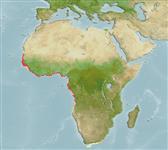Common names from other countries
Environment: milieu / climate zone / depth range / distribution range
экология
; пределы глубины 1 - 55 m (Ref. 435), usually 10 - 30 m (Ref. 435). Tropical; 20°N - 17°S
Eastern Atlantic: from Mauritania to Angola.
Length at first maturity / Size / Вес / Возраст
Maturity: Lm ? range ? - ? cm Max length : 9.3 cm CL самец/пол неопределен; (Ref. 435)
Maximum carapace width: 19.0 cm (Ref. 435). Also caught by trammel nets (Ref. 417). Occurs at depths from 1 to 55 m, common at depths of 10 to 30 m. Inhabits shallow coastal waters with bottoms consisting of sand or mud (Ref. 435).
Life cycle and mating behavior
половая зрелость | размножение | нерест | икра | Fecundity | личинки
Members of the order Decapoda are mostly gonochoric. Mating behavior: Precopulatory courtship ritual is common (through olfactory and tactile cues); usually indirect sperm transfer.
Основная ссылка
ссылки | координатор | соавторы
Fischer, W., G. Bianchi and W.B. Scott (eds.). 1981. (Ref. 435)
Статус Красного Списка МСОП (Ref. 130435)
Статус СИТЕС (Ref. 108899)
Not Evaluated
Not Evaluated
Угроза для людей
Harmless
Использование человеком
рыболовство: коммерческий
| FishSource |
инструменты
дополнительная информация
ресурсы в Интернет
Estimates based on models
Preferred temperature
(Ref.
115969): 22.7 - 28, mean 26.6 (based on 50 cells).
Уязвимость
Low vulnerability (10 of 100).
